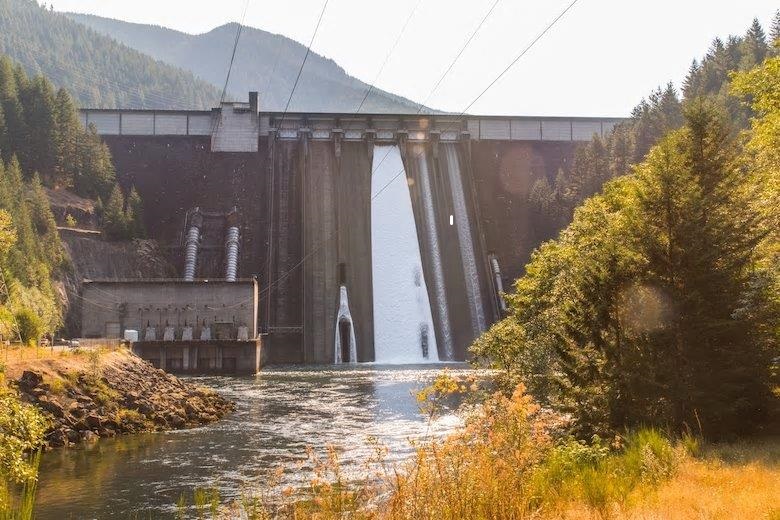The U.S. Army Corps of Engineers, Portland District has finalized a Finding of No Significant Impact for the Environmental Assessment of the reservoir pool reduction at Willamette Valley’s Detroit Dam in response to a seismic hazard analysis last year.
Detroit Dam’s maximum pool elevation this summer drops five feet from 1,563.5 feet down to 1,558.5 feet as a way to reduce the likelihood of overstressing the spillway gates during a large earthquake. The change, according to the Corps, might impact boat ramp access in some years.
The Corps developed the EA to evaluate the environmental impacts of this summer’s conservation pool restriction at the dam.
The Corps “has determined that the Proposed Action is not likely to result in significant impacts on the human environment, and therefore an environmental impact statement (EIS) will not be prepared.” The FONSI is included with the final EA. The final EA also includes a summary of comments received on the Draft EA.
Detroit Dam is tucked into the Cascade Mountains River near the small city of Detroit on the North Santiam River, a tributary of the Willamette River in Oregon. It’s located about 150 miles east of the Cascadia Subduction Zone, a megathrust fault along the Oregon Coast, the Corps says in its environmental assessment for the proposed change. The Cascadia Subduction Zone is capable of producing very large, long duration earthquakes every 300-500 years. The reservoir itself spans the Linn County-Marion County border.
Just last year in February the Corp announced a restriction on pool elevations at two other Willamette River dams for the same seismic reason. Those restrictions became effective in the spring. Worried that a catastrophic earthquake could damage the dams, the agency said last year that it would not allow Hills Creek and Lookout Point dams’ reservoirs to fully fill. The two dams are on the Middle Fork Willamette River.
The Corps updated its seismic analysis for Detroit Dam’s spillway gates in 2020, finding that the risk is higher than previous assessments.
“The performance of the spillway gates in an earthquake is a function of the potential ground motions due to an earthquake, the height of the gates above the dam foundation, and the water level acting on the gates at the time of an earthquake,” the EA says. “Structural analysis of the spillway gates has shown there is a possibility for buckling of the spillway gate’s supporting arms resulting in an uncontrolled release of water from the dam.”
The Corps warned of devastating flooding in areas downstream of the dam in the North Santiam’s narrow canyon and further downstream in Oregon’s capitol of Salem, a large center of population, if the spillway gates buckle.
“Therefore, immediate action is warranted to reduce risk to acceptable levels,” the EA says. “Targeted measures (called Interim Risk Reduction Measures) will be implemented in spring 2021 to reduce life-safety risk while issues are evaluated further. These measures include reducing the maximum conservation pool (the highest allowable level during summer) of Detroit reservoir by 5 feet.”
For Background, see:
— CBB, March 18, 2021, CONCERNED ABOUT CATASTROPHIC EARTHQUAKES, CORPS PROPOSES TO REDUCE POOL ELEVATION AT DETROIT DAM TO REDUCE STRESS ON SPILLWAY GATES https://www.www.www.columbiabasinbulletin.org/concerned-about-catastrophic-earthquakes-corps-proposes-to-reduce-pool-elevation-at-detroit-dam-to-reduce-stress-on-spillway-gates/
— CBB, February 6, 2020, “Portland District Corps Studies Vulnerability Of Dams To Cascadia Earthquake; Expects Little Damage, Some ‘Deformations,’” https://www.www.www.columbiabasinbulletin.org/portland-district-corps-studies-vulnerability-of-dams-to-cascadia-earthquake-expects-little-damage-some-deformations/
— CBB, August 12, 2016, “Research: Big Earthquakes In Cascadia Subduction Zone More Frequent, Historically, Than Thought,” https://www.www.www.columbiabasinbulletin.org/research-big-earthquakes-in-cascadia-subduction-zone-more-frequent-historically-than-thought/
— CBB, August 8, 2014, “New Report Says Nearly Forgotten Research Decades Ago Complicates Predicting Huge NW Earthquakes,” https://www.www.www.columbiabasinbulletin.org/new-report-says-nearly-forgotten-research-decades-ago-complicates-predicting-huge-nw-earthquakes/

